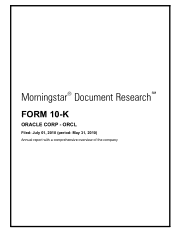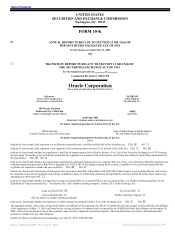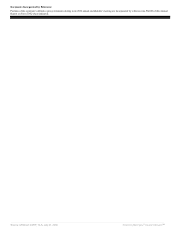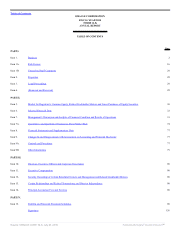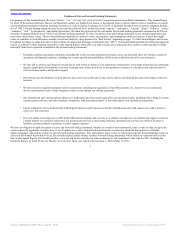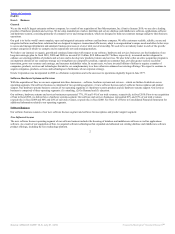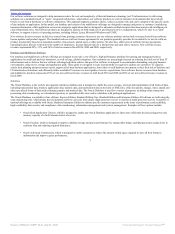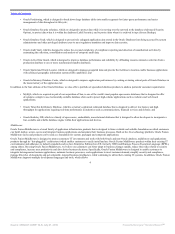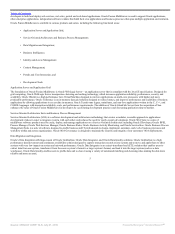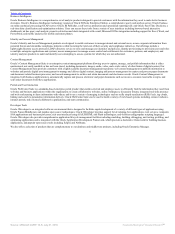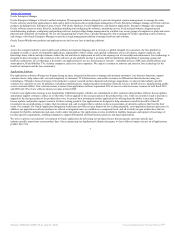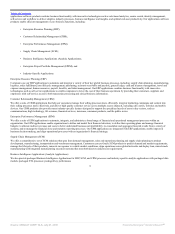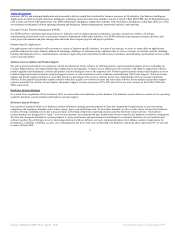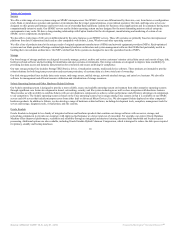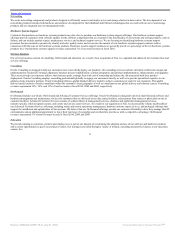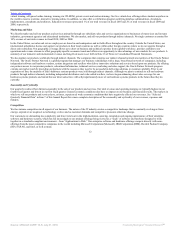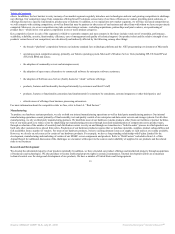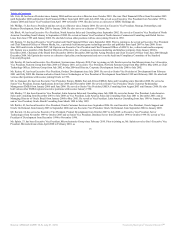Oracle 2009 Annual Report Download - page 9
Download and view the complete annual report
Please find page 9 of the 2009 Oracle annual report below. You can navigate through the pages in the report by either clicking on the pages listed below, or by using the keyword search tool below to find specific information within the annual report.
Table of Contents
developers to build and deploy web services, web sites, portals and web-based applications. Oracle Fusion Middleware is used to support Oracle applications,
other enterprise applications, independent software vendors that build their own applications and business processes that span multiple application environments.
Oracle Fusion Middleware is available in various products and suites, including the following functional areas:
• Application Server and Application Grid;
• Service-Oriented Architecture and Business Process Management;
• Data Migration and Integration;
• Business Intelligence;
• Identity and Access Management;
• Content Management;
• Portals and User Interaction; and
• Development Tools.
Application Server and Application Grid
The foundation of Oracle Fusion Middleware is Oracle WebLogic Server—an application server that is compliant with the Java EE specification. Designed for
grid computing, Oracle WebLogic Server incorporates clustering and caching technology, which increases application reliability, performance, security and
scalability. Oracle JRockit is a high performance Java Virtual Machine designed to run Java applications on multi-core processors with higher and more
predictable performance. Oracle Coherence is an in-memory data grid solution designed to reduce latency, and improve performance and scalability of business
applications by allowing applications to access data in-memory. Oracle Tuxedo runs legacy, mainframe, and non-Java applications written in the C, C++, and
COBOL languages with transaction reliability, scale, and performance requirements. The addition of Oracle GlassFish Server from the acquisition of Sun
enhances the value of Oracle Fusion Middleware for developers by accelerating development practices and decreasing application time-to-market.
Service-Oriented Architecture Suite and Business Process Management
Service-Oriented Architecture (SOA) is a software development and architecture methodology that creates a modular, re-usable approach to applications
development; makes it easier to integrate systems with each other; and reduces the need for costly custom development. Oracle SOA Suite is a suite of
middleware software products used to create, deploy, and manage applications on a Service-Oriented Architecture including Oracle JDeveloper, Oracle BPEL
Process Manager, Oracle Web Services Manager, Oracle Business Rules, Oracle Business Activity Monitoring, and Oracle Service Bus. Oracle Business Process
Management Suite is a suite of software designed to enable business and IT professionals to design, implement, automate, and evolve business processes and
workflow within and across organizations. Oracle SOA Governance is designed to maintain the security and integrity of our customers’ SOA deployments.
Data Migration and Integration
Oracle’s Data Integration offerings consist of Oracle GoldenGate, Oracle Data Integrator, and Oracle Data Quality solutions. Oracle GoldenGate is a high
performance data movement and continuous availability solution designed to capture transaction records on one system and to move and apply them to other
systems with very low impact on system and network performance. Oracle Data Integrator is an extract-transform-load (ETL) solution that enables users to
extract data from one system, transform it from the source system’s format to a target system’s format, and load it into the target system (such as a data
warehouse). Oracle Data Quality enables users to profile data and to clean it using a variety of automated matching and cleansing rules making the data more
reliable and more accurate.
5
Source: ORACLE CORP, 10-K, July 01, 2010 Powered by Morningstar® Document Research℠

